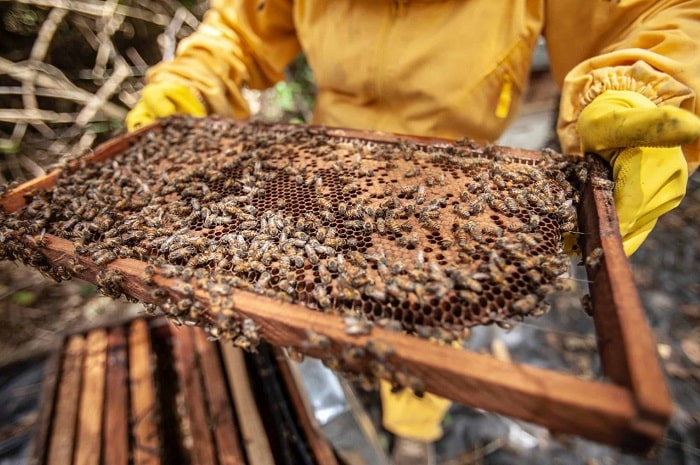Honey extractors are very useful equipment. Even though their requirements are debatable, if used correctly, they can boost your honey harvest. They may appear to be complex pieces of technology, but using them is easier than you may think.
This procedure is excellent since the wax and comb are preserved and may be returned to the hive. In principle, it appears simple, but how to use the honey extractor? Do not be afraid of them. We are going to demonstrate how simple it is to utilize a honey extractor. You do not need a physics degree to comprehend them, just like you don’t need one for other pieces of beekeeping equipment.

What are honey extractors?
Maybe you already know, but we want to briefly say again what is a honey extractor?
Honey extractors are simple equipment that extracts honey without breaking or harming the combs. They are ideal for beekeepers that plan to sell their honey commercially or who need to produce as much honey as possible. The fact that honey extractors are expensive. They are not always worthwhile if you aren’t making a profit or your honey production is low.
Getting ready
Before you begin extraction, make sure you are fully prepared. Make sure that you have all of your tools clean and ready to go. You should gather the following tools:
- An extractor.
- A hot knife (a plugin knife that heats up) – used for cutting off wax cappings on the honeycomb.
- A strainer – any strainer you like that has fine pores (some beekeepers even use pantyhose).
- A bucket – used for collecting extracted honey.
- A measuring cup – used for pouring the extracted honey into smaller containers.
- A cookie sheet – used for catching wax cappings which are cut off with the hot knife.
- Honey jars – used for storing honey.
Extraction of honey
Honey extraction with a honey extractor is straightforward and can be accomplished in a few simple steps.
Collect your frames
Fully capped combs should be removed from your hive, ideally the day before. Make careful to keep the combs somewhere inside where bees can’t get to them. Because bees can follow their honey quite well, don’t let them sniff or reach for it.
Choose a location
It is best to perform it indoors so that bees can not access the exposed honey. Your garage may be an ideal location because you can readily wipe up any sticky spills. The extraction can be done outside. But the exposed honey may attract bees, which may be a nuisance. And some may drown in honey.
Once you have decided on a location, position the extractor so that it is easy to navigate around. You can place a bucket beneath its bottom spigot to collect the extracted honey. To make the process go more smoothly, you should lay a strainer on top of the bucket so the honey can be filtered immediately.
Uncap the honey
With the hot knife, you may remove the honey cap. Be extremely cautious in this phase since the hot knife heats up quickly and can cause severe burns if it comes into touch with your skin.
After heating the knife, you can use it to slit the sides of the comb to reveal the liquid honey. Do not rush this step if you do not want to cut the comb too deeply. You should cut only 1 centimeter.
Use the extractor
After removing the caps, insert the combs within the honey extractor baskets. Depending on the type of extractor you have, you may have to spin the combs manually or automatically.
The crankshaft handle on manually operated honey extractors spins the combs. The centrifugal force draws the honey out onto the inside wall of the extractor by spinning the combs. The honey then oozes down the sides and pours out of the bottom spigot. As the honey flows from the faucet, it gathers.
The spinning of the combs may cause the honey extractor to become unstable, especially if the spinning is quick. The quicker they spin, though, the more honey is extracted.
After spinning for at least 1 minute, you should check if the honey has come out from the side opposite the inner wall of the extractor. If there is any remaining honey, spin it some more. Otherwise, turn the frame around and extract the opposite side. When you’re finished with the current batch, add more frames and repeat the process until all frames are completed.

Collect the honey
It could take a few minutes before you notice any honey seeping from the spigot. When it first starts, it normally takes 1-2 hours to collect and filter data.
When the honey has stopped seeping, transport the bucket to where you will fill the jars. You can place a bowl beneath the spigot in case some honey drips later. As a result, you will not have to clean it up on the floor.
Store the honey in jars
Empty frames should be returned to the hives. They will repair the combs and replenish them with honey shortly after you return to them. As you can see, the procedure is quite simple, and one may do it effectively. But, do not forget to clean the honey extractor and any tools used to avoid attracting bees.
Because honey is water-soluble, you can clean things with hot water. You can place the wax left over from cutting off comb caps on a cookie sheet and give it to bees for a few hours. They will remove all the honey from the wax, which you may then store for future use.
Conclusion
Why not use a honey extractor to extract all the honey fast and easily? If you don’t have enough money right now, you can use used honey extraction equipment. Don’t let a brilliant device like this go to waste.
Related Post
